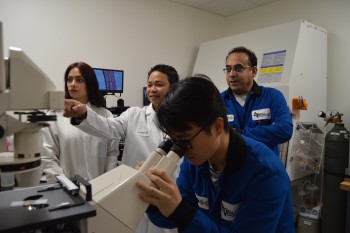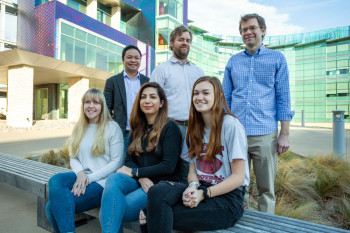Postdoc - Biomedical Magnetic Resonance
University of Texas Southwestern Medical Center - 2014

Lloyd Lumata
Associate Professor - Physics
Affiliate Faculty - Systems Neuroscience Program
Professional Preparation
PhD - NMR Physics
National High Magnetic Field Laboratory at Florida State University - 2008
National High Magnetic Field Laboratory at Florida State University - 2008
B.S. - Physics
Western Mindanao State University (Philippines) - 2002
Western Mindanao State University (Philippines) - 2002
Research Areas
Dynamic Nuclear Polarization (DNP) Instrumentation Development
we assemble instruments called DNP hyperpolarizer -- a physics-based technology that enhances the magnetic resonance imaging (MRI) signals by >10,000-fold.see one of the instruments that we built: https://onlinelibrary.wiley.com/doi/full/10.1002/mrc.4624
DNP optimization
we optimize the DNP signals to obtain the highest possible MRI signal enhancements ranging from 10,000-50,000-fold or higher.see: https://pubs.acs.org/doi/abs/10.1021/acs.jpclett.8b01687
Application of DNP technology to cancer metabolic imaging
we apply the super-enhanced MRI signals (>10,000-fold) for metabolic imaging of cancer and other pathologies with superb sensitivity and high specificity.see review article: https://www.sciencedirect.com/science/article/pii/S0076687915002670
Publications
Magnetic-Field-Dependent Lifetimes of Hyperpolarized 13C Spins at Cryogenic Temperature 2018 - Journal Article
Transition Metal Doping Reveals Link between Electron T1 Reduction and 13C Dynamic Nuclear Polarization Efficiency 2017 - Journal Article
Construction and 13C hyperpolarization efficiency of a 180 GHz dissolution dynamic nuclear polarization system 2017 - Journal Article
Assembly and performance of a 6.4 T cryogen‐free dynamic nuclear polarization system 2017 - Journal Article
Influence of 13C Isotopic Labeling Location on Dynamic Nuclear Polarization of Acetate 2017 - Journal Article
Construction and 13 C hyperpolarization efficiency of a 180 GHz dissolution dynamic nuclear polarization system 2017 - Journal Article
Assembly and performance of a 6.4 T cryogen-free dynamic nuclear polarization system 2017 - Journal Article
Awards
Frisco ISD Independent Study and Mentorship (Mentor) - Frisco ISD [2017]
FSU Program for Instructional Excellence (PIE) Award - Florida State University [2007]
Appointments
Advisory council member
National High Magnetic Field Laboratory [2017–2019]
Users advisory committee member of the Electron Magnetic Resonance (EMR) program of the National High Magnetic Field Laboratory (NHMFL) in Tallahassee, FL
National High Magnetic Field Laboratory [2017–2019]
Users advisory committee member of the Electron Magnetic Resonance (EMR) program of the National High Magnetic Field Laboratory (NHMFL) in Tallahassee, FL
Chair
Institutional Biosafety and Chemical Safety Committee at UT Dallas [2017–2019]
reviews the biosafety and chemical safety aspects of research protocols at UT Dallas.
Institutional Biosafety and Chemical Safety Committee at UT Dallas [2017–2019]
reviews the biosafety and chemical safety aspects of research protocols at UT Dallas.
Chair
UTD Physics Renfrow Scholarship Committee [2017–2019]
reviews applications for travel and research-related graduate scholarship of physics students.
UTD Physics Renfrow Scholarship Committee [2017–2019]
reviews applications for travel and research-related graduate scholarship of physics students.
Projects
DNP Instrumentation and Hyperpolarized Magnetic Resonance Imaging (MRI) of Aberrant Cancer Metabolism
2014/06 Our lab's main research is focused on hyperpolarized magnetic resonance: instrumentation, physics, optimization methods and biomedical applications (specifically, aberrant cellular metabolism in cancer). Hyperpolarization, technically dynamic nuclear polarization (DNP), is a physics technique wherein we create a high degree of non-Boltzmann distribution of insensitive nuclear spins at low temperature and high magnetic field via microwave irradiation of free electrons. Our goal is to get the highest enhanced nuclear polarization possible for insensitive nuclear spins such as 13C, 15N, 89Y, 107,109Ag etc. by optimizing the physical parameters at cryogenic conditions (close to 1K). We then utilize a fast dissolution device that converts the frozen hyperpolarized samples at cryogenic conditions into hyperpolarized liquids at physiologically tolerable temperatures. What this means is that the NMR and MRI signals of reporter molecules (NMR/MRI molecular probes that can detect pH, metabolism, and other important biological activities) are enhanced by 10,000-100,000-fold! We aim to explore and investigate new hyperpolarized NMR and MRI biosensors to improve medical diagnostics.Presentations
see the complete list at: https://dnpnmr.weebly.com/presentations.html
News Articles
Researchers Receive $4.5 Million in Funding for Cancer Projects
 Dr. Lloyd Lumata, assistant professor of physics, will use his $200,000 CPRIT grant to develop a new noninvasive imaging technique that could detect glioblastoma earlier and more accurately. The technique uses hyperpolarization technology to boost by more than 10,000-fold the sensitivity of MRI signals from key biological molecules associated with glioblastoma.
Dr. Lloyd Lumata, assistant professor of physics, will use his $200,000 CPRIT grant to develop a new noninvasive imaging technique that could detect glioblastoma earlier and more accurately. The technique uses hyperpolarization technology to boost by more than 10,000-fold the sensitivity of MRI signals from key biological molecules associated with glioblastoma.In addition to mapping cancer in the brain more precisely, the technology could reduce the need for patient exposure to X-rays from CT scans and radioactive imaging tracers, or for removal of brain tissue for diagnosis.
Researchers at UT Dallas advance fight to end cancer
 Assistant professor of physics Lloyd Lumata is developing a noninvasive imaging technique that could detect glioblastomas earlier and with more accuracy.
Assistant professor of physics Lloyd Lumata is developing a noninvasive imaging technique that could detect glioblastomas earlier and with more accuracy.University’s Seed Grant Initiative Helps Researchers’ Pursuits Blossom
 Among the seven programs is the Collaborative Biomedical Research Award (CoBRA), which was specifically designed to stimulate interdisciplinary research between faculty at UT Dallas and UT Southwestern Medical Center. Three projects led by Dr. Danieli Rodrigues, associate professor of bioengineering; Dr. Lloyd Lumata, assistant professor of physics; and Dr. Lawrence Reitzer, professor of biological sciences, each received $250,000.
Among the seven programs is the Collaborative Biomedical Research Award (CoBRA), which was specifically designed to stimulate interdisciplinary research between faculty at UT Dallas and UT Southwestern Medical Center. Three projects led by Dr. Danieli Rodrigues, associate professor of bioengineering; Dr. Lloyd Lumata, assistant professor of physics; and Dr. Lawrence Reitzer, professor of biological sciences, each received $250,000.
Researchers Brighten Path for Creating New Type of MRI Contrast Agent
 University of Texas at Dallas researchers are breathing new life into an old MRI contrast agent by attaching it to a plant virus and wrapping it in a protective chemical cage.
University of Texas at Dallas researchers are breathing new life into an old MRI contrast agent by attaching it to a plant virus and wrapping it in a protective chemical cage.The novel strategy is aimed at developing a completely organic and biodegradable compound that would eliminate the need to use heavy metals such as gadolinium in contrast agents, said Dr. Jeremiah Gassensmith, associate professor of chemistry and biochemistry in the School of Natural Sciences and Mathematics and corresponding author of a study published Feb. 5 in the journal Chemical Science, a publication of the Royal Society of Chemistry.
Hyperpolarized Magnetic Resonance: Enhancing NMR and MRI Signals by >10,000-fold for Metabolic Assessment of Cancer
 Nuclear magnetic resonance (NMR) spectroscopy and imaging (MRI) of nuclei other than a proton, especially of mass-limited samples, is hampered by the low signal sensitivity due to the tiny differences in spin populations between the nuclear Zeeman energy levels. This intrinsic NMR insensitivity of nuclei such as carbon-13 or nitrogen-15 stems from their relatively low gyromagnetic ratio, leading to lower Boltzmann-dictated thermal nuclear polarization, thus lower NMR or MRI signal. Dynamic nuclear polarization (DNP) or hyperpolarization via the dissolution method, an offshoot of a technology used in particle physics and nuclear scattering experiments, has solved this insensitivity problem by amplifying the magnetic resonance signals of insensitive nuclei such as carbon-13 by >10,000-fold. In this process, a sample with the target nuclei is typically dissolved in a glassing matrix (e.g. glycerol:water solution) and doped with trace amount of stable organic free radicals (e.g. trityl OX063 or TEMPO). The trick is to transfer the high electron thermal polarization to the nuclear spins via microwave irradiation close to the electron spin resonance (ESR) frequency of the free radicals at low temperature (close to 1 K) and high magnetic field (>1 T). To harness these amplified NMR signals at cryogenic temperatures, the frozen polarized samples are rapidly dissolved into hyperpolarized liquids at physiologically tolerable temperatures in a span of 5-10 s. These hyperpolarized liquids are then administered in vitro in NMR tubes with cancer cell suspensions or injected in vivo in living subjects for real-time biochemical monitoring and imaging of cellular metabolism. In this talk, I will delve into the discussion of the physics, instrumentation and engineering aspects, optimization methods, and biomedical applications of the dissolution DNP technology. This cutting-edge physics technology is currently improving cancer diagnostics by providing biochemical and metabolic information at the molecular level with superb sensitivity and high specificity.
Nuclear magnetic resonance (NMR) spectroscopy and imaging (MRI) of nuclei other than a proton, especially of mass-limited samples, is hampered by the low signal sensitivity due to the tiny differences in spin populations between the nuclear Zeeman energy levels. This intrinsic NMR insensitivity of nuclei such as carbon-13 or nitrogen-15 stems from their relatively low gyromagnetic ratio, leading to lower Boltzmann-dictated thermal nuclear polarization, thus lower NMR or MRI signal. Dynamic nuclear polarization (DNP) or hyperpolarization via the dissolution method, an offshoot of a technology used in particle physics and nuclear scattering experiments, has solved this insensitivity problem by amplifying the magnetic resonance signals of insensitive nuclei such as carbon-13 by >10,000-fold. In this process, a sample with the target nuclei is typically dissolved in a glassing matrix (e.g. glycerol:water solution) and doped with trace amount of stable organic free radicals (e.g. trityl OX063 or TEMPO). The trick is to transfer the high electron thermal polarization to the nuclear spins via microwave irradiation close to the electron spin resonance (ESR) frequency of the free radicals at low temperature (close to 1 K) and high magnetic field (>1 T). To harness these amplified NMR signals at cryogenic temperatures, the frozen polarized samples are rapidly dissolved into hyperpolarized liquids at physiologically tolerable temperatures in a span of 5-10 s. These hyperpolarized liquids are then administered in vitro in NMR tubes with cancer cell suspensions or injected in vivo in living subjects for real-time biochemical monitoring and imaging of cellular metabolism. In this talk, I will delve into the discussion of the physics, instrumentation and engineering aspects, optimization methods, and biomedical applications of the dissolution DNP technology. This cutting-edge physics technology is currently improving cancer diagnostics by providing biochemical and metabolic information at the molecular level with superb sensitivity and high specificity.
Affiliations
Affiliated Faculty
2022/08Associate Professor, Department of Neuroscience, University of Texas at Dallas
Affiliated Faculty
2023/08Associate Professor, Department of Bioengineering, University of Texas at Dallas